Menus
Superbike
One second better in the lap! This is the promise of Aprilia evoking its new RSV4 RR and RF, compared to their predecessors. And knowing the current performance of these machines as powerful as they are stylish, it is not nothing. But sport is the soul of Aprilia, the raison d’être of Noale’s firm with 54 world titles (all competitions combined). And its sporty big cube is a monument, a benchmark for hyper-sport machines: the extension of a line that started in 1998 with the RSV Mille and which has gone through four successive generations..
Powered by a Rotax twin cylinder when it was created in 1998, the 60 ° V-block of the RSV 1000 then developed 128 hp at 9,250 rpm and 10.3 da.Nm of torque at 8,000 rotations / min.
To follow the development of the competition with four cylinders, the machine is magnified in 2009 by the adoption of a completely new mechanics V4. New and explosive, open at 65 °, the double V-twin delivers 180 HP at 12,500 rpm and a force of 11.5 da.Nm at 10,000 rpm under control of electronics derived from racing. Thus, winning 7 trophies in 6 years (driver and / or manufacturer), the RSV4 has become THE undisputed star of the Superbike championship. In 2015, the sport diva benefited from major mechanical developments to deliver 201 nags at 13,000 revolutions and 11.5 da.Nm at 10,500 rpm,
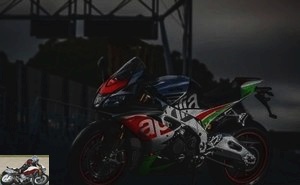
Two years later, the Italian manufacturer wants to take back control of a rapidly changing segment. Indeed, Kawasaki ZX10R in 2016 then Honda CBR1000RR and especially Suzuki GSXR1000R at the start of 2017 set new milestones in efficiency and performance. Aprilia therefore once again takes care of its muse of the tracks, optimizing especially its electronics, but also fiery V4. On the menu, general performance and reliability while having, moreover, passed Euro4 standards ….!
It is in the surroundings of Milan, on the turnstile of San Martino del Lago that we test the high-end version RSV4-RF.

Discovery
The stated objective of the RSV4s is to once again be the most efficient sports cars on the market. And to do this, the electronics of the APRC (Aprilia Performance Ride Control) and mechanics are evolving in depth. In fact, outwardly, almost nothing signals so much new.
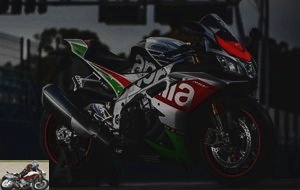
Benefiting from a chiseled aesthetic already refined in 2015, the 2017 vintage only evolves on one point: its exhaust. The "enormous" Euro4 therefore significantly increases its silencer, but, a design reference, the RSV4 know how to manage this problem with a very Italian class. The new satin stainless steel element has a narrow volume finished with a pentagonal tip and therefore fits nicely into the machine. Hyper-compact, the latter is always impressive in finesse and retains its podium dress, mixing taut curves and salient angles. The triple optic still marks the front face as well as the projecting ridges forming, above the blanks, mini-fins.
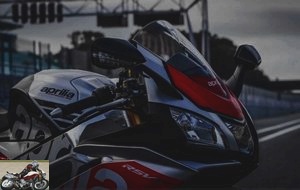
Unchanged, the capacity of the tank is 18.5 liters and the minimalist rear loop supports slender passenger footrests, concealing the seat of the latter under a seat cowl with short wings. The sculpted and complex curves always seduce with the overall elegance and finesse.
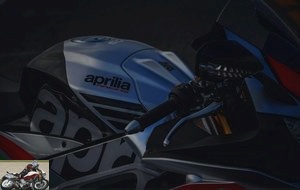
Supporting the whole, we find the superb and massive double-beam aluminum frame whose polishing contrasts with the reinforcements and plates with surfaces left untreated. The cycle part retains its dimensions. As a reminder, in 2015, the evolutions ensured the management of the power and an optimal handling..
But it is at the heart of the machine that the new efficiency of the RSV4 resides, within the guts of the engine and the electronic network managing the piloting assistance. The watchword is: "Maintain power by switching to Euro4". Filled with state-of-the-art chips making up the fully modernized APRC system, RSV4-RF and RR 2017 are still powered by a 65 ° longitudinal V4 of 999.6 cm3, fully improved, no part of which would be compatible with the 2015-2016 opus. The internal guided tour starts in the technical section. For the impatient, go in the saddle.
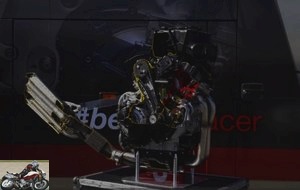
The RF admits 204 kg ready to race, 4 less than the 2015 version and finally stands out with its specific graphics. Sachs suspensions (43 mm inverted fork is adjustable in any direction and its base forged in aluminum), cast aluminum rims, on the scale, the RR is heavier (rims, suspensions) admitting 208 kilos.

Particularly attractive, the RSV4-RF is remarkably finished and equipped. The fit of the elements, the quality of the components and the coating of the majority of the metal surfaces are beyond reproach. Only a large hose on the left side spoils the profile a little. The surfaces of the cylinder blocks and center crankcases always show a rough finish, ultimately giving the machine a racing feel..
In the saddle
Compact, narrow, the RSV4-RF is a real competition machine, with distinctive and specific ergonomics. It is indeed particularly high, with 840 mm of saddle height (down from 7 units, this remains 15 more than the Suzuki GSXR1000R). This seat is long enough, but above all remarkably designed to promote sporting gestures with its sloping sides. This always adds to the machine tilting forward, rocking the rider on fairly low half-handlebars. With very marked notches, the tank forms significant ridges at the top, very effective for wedging the legs. The latter are also significantly raised, resting on high perched footrests guaranteeing significant ground clearance..
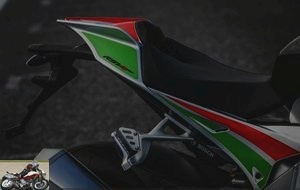
On board, there is therefore a racing atmosphere, with a position dedicated to performance. The RSV4s have a brand new cockpit. The top tee is dressed in black and offers a more pleasant appearance. We have a new dashboard that gives way to all digital, grouping the instruments on a large color TFT screen. Topped with a large shiftlight, the screen automatically switches to day or night mode and has two different displays, road or circuit. On the latter, the provision of information gives pride of place to sport. It thus groups together, under the highly readable bar-graph tachometer, the chrono or speed display, the gear engaged and the speed limit chosen for the pitlane (or cruise control). Also, the information of the APRC is judiciously grouped on the left, with the engine map selected, the level of ATC, ABS, AWC and ALC desired (anti-skid, ABS, anti-wheeling and standing start. A menu allows also to enter in more detail if desired..
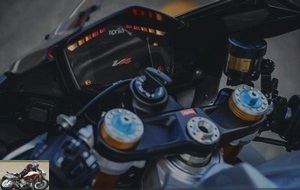
To control the whole, the ergonomics of the stems is a strong point of Aprilia sports cars. The famous + and – mini-paddles always control the traction control (ATC) directly and without turning off the throttle or disengaging. The engine modes are chosen by pressing the starter, once the V4 is running. Finally, new buttons on the left stalk manage the AWC, the Pit Limiter and we even note the appearance of a multi-directional navigation cursor! In addition, there is now no electronic latency at the time of changes. Only the selection of APRC joystick aids requires a little practice to be precise. Finally, the clutch lever is not adjustable in spacing.
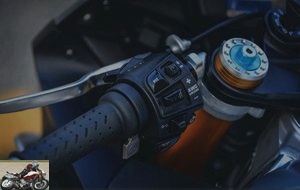
On track
It’s time to get back on the route of the 3,450 m Italian turnstile. Particularly contrasted, it combines hairpins and more straightforward turns of nearly a kilometer. A real very informative test bench to judge the evolutions of Aprilia. And the Franco-Italian organization gives us the benefit of heating blankets in order to get to work from the first meters.
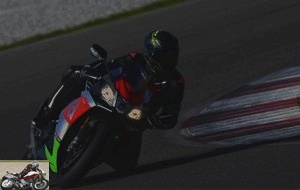
An RSV4 is also an unparalleled sound. Admittedly a little more stifled at idle by Euro4, the V4 wakes up as soon as we day a little of the handle. The air roars under the inimitable rumble of the superbike. Half of our testing machines are equipped with optional Akrapovic silencers, thus benefiting from race mapping. With in particular a different engine brake mapping with longer injection time in order to cool the valves. Thus equipped, the RSV4-RF finds its usual voice, but also its mechanical verve at any speed. Indeed, the approved silencer closes its valve on the second report at less than 5,500 revolutions. With the effect of limiting very slow hairpin reminders. It will then be necessary to pass this zone first…. or change the mapping, then losing the "very clean" approval. But only a fairly specific sector gave us this concern.
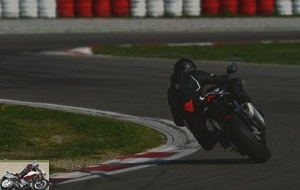
It is with impatience that I set off to explore the route. The first laps on the Aprilia handlebars require the rider to get back into phase with a racing-style machine. Especially on a track with a varied pace. Perched on the Italian, one seems to be riding, on its spine a beast full of life that should not be rushed to make it obey the finger and the eye. The particular ergonomics of the Italian can be learned quickly, requiring careful, smooth and fast piloting. Original, the sportswoman of Noale then gives an unusual approval. Hoarse and deep, the vocalizations of the RF are an enchantment, underlining its evolutions with an intoxicating sound signature. Exuberant, the particular mechanics of the Aprilia are a weapon of seduction, especially on mid-revs. Always more responsive, the V4 takes its turns with vigor and without inertia, finely guided by a grip of the most precise throttle. A little more abrupt in "Race" or "Track" mode, the electronics give a more easily manageable response, at the beginning, in "Sport". The ease coming, we appreciate to control the mechanics without filter. The accelerator seems "linked to the rear wheel" as the stimuli are obvious to dose or the gas to maintain in curves.
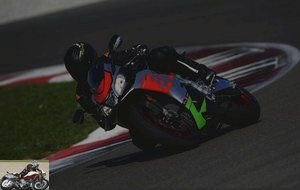
Enough to effectively pass the 201 horsepower and 11.5 da.Nm of torque of the block, especially as the APRC system is on hand at all times to lose nothing. Anti-skating and anti-wheeling allow any pilot to catapult himself off the curve, without sweating and at his own pace. Pressing the dedicated push buttons and these variables can be adjusted directly according to your wishes or your current progress. Unique and very useful. Aprilia electronics, benchmarks in terms of precision and reliability, here demonstrate a constant improvement in quality. Therefore, leaving long commas of eraser on the angle is quickly a pleasure as the battery of chips is reactive and progressive..
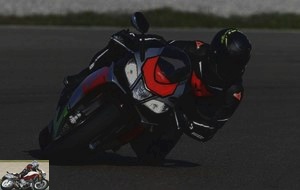
However, the sports car remains a lively, but healthy motorcycle, due to a fairly high center of gravity and a particular, inclined geometry. Thus, the front axle moves under the load of the engine in a straight line, but the steering damper is on standby. But the machine is also making progress in terms of stability. Dented, the development of the circuit highlights another quality of the new opus: its suspensions. Efficient, the connections to the ground are in clear improvement and proves the evolution compared to the 2105 version, whose stability on the relaunches was questionable. With its new design, the shock absorber rod is no stranger to this observation. The RSV4-RF is thus made more stable and tolerant, in all phases of driving, to the movements of the pilot..
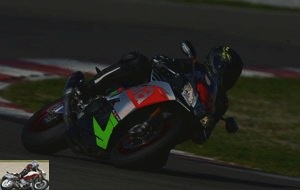
Fork and shock absorber work together at all times to stem any jolts. In addition, fully configurable, the elements are responsive to settings. As the laps progressed, I was able to increase my speed of passage over sectors that were nevertheless undulating in bends and at sustained speed..
Finally the straight line. At high speed, the sports car does little to protect large riders, because of a narrow bubble, but lets the pilot back up on the saddle. The reports add up from the tip of the boot as the shifter is precise and the control smooth. And ditto downhill, in the hoarse yelping of the V4…. Anti-dribbling, the clutch swallows everything without flinching, while the calipers bite the discs and the rear wheel anti-lift stabilizes the machine; in fact, the RSV4-RF does not sweep the track. We hardly feel a little movement on the strongest decelerations. Particularly effective, these are facilitated by an excellent feeling and an easy modulation of the brakes at the handle. The ABS is transparent in its operation and not very sensitive and it is easy to keep the brakes on the angle. Especially with the new anti-lock when cornering…. We also appreciate the marked curves of the tank to wedge his thighs under braking.
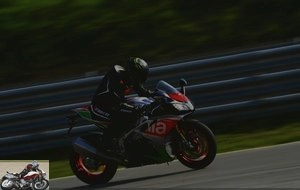
Often tried on faster and less restrictive routes for the cycle part, the 2017 vintage here displays remarkable liveliness in the sequences. Credit also goes to the forged rims of the RF…. a weight advantage: 2 kg at the rear and 0.8 at the front in unsprung mass; not to mention the gyroscopic effect. A definite asset for driving the RSV4 by sight. The production superbike is responsive to the pressure on its high footrests. But, personally, I slipped and lost, several times the contact with them. Rather a concern of boots it seems. No matter, the Italian dives in turns with passion and the ground clearance seems unfathomable, much greater than that of her competitors, also conferring an appreciable ease..
It’s time to join the stands…. Alas. I take this opportunity to activate the APL, limiting the speed in the pitlane…. efficient, it disengages as soon as the second is passed.
Conclusion
The benchmark outsider for nearly 10 years, the Aprilia RSV4-RF is evolving in every way, consolidating qualities already acclaimed. Mechanics and electronics are, more than ever, paired to give the quintessence of the Italian. The superbike also benefits from high-performance suspensions and perfectly adjusted damping. An experienced and demanding pilot machine, Noale’s seductive beast works wonders between the gloves of an enlightened or seasoned amateur. Only its original exhaust and its mapping to Euro4 standards can hinder certain evolutions at low speed..
I was impatiently awaiting this test to compare my impressions with the 2017 sports novelties. And in particular the Suzuki GSXR1000RR tested at Phillip Island. The circuits have nothing in common, but these two machines are successes, both typed competition.
Equipped with remarkable mechanics, the Italian does not forget to be perfectly finished, but also a little more complex than a GSXR1000RR. Less refined, the Japanese rather works on efficient pragmatism. The latter asks for € 18,999 for the R version comparable to our transalpine (€ 15,999 as standard). The RSV4-RR is displayed at 17,499 (or 300 € more with up and down shifter and many electronic and mechanical evolutions) and the RF version of our test is exchanged for 20,999 €. The price of a superior finish: forged rims, TFT color screen, complex electronics and more flexible on the handlebars…. Another competitor, the Kawasaki Ninja ZX10R, less technological, claims 17,799 € and the Honda CBR1000RR Fireblade 17,999 € as standard, but 22,499 € in SP version comparable to the Italian.
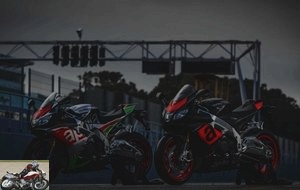
Thus reworked, the RSV4-RF remains brilliantly in the hypersport race. Elegant, stylish and above all original both in design and in mechanics, the Noale supersport refines its performance without losing any of its character. Like what Europe will not prevent the expression of remarkable and demanding singularities.
Strong points
- Racy aesthetics
- Engine character and availability
- Performances
- State-of-the-art electronics
- Agility of the cycle part
- Premium cushioning
- Addictive and elegant sound
Weak points
- Low speed recovery in seconds to Euro4 standards
Aprilia RSV4 RF technical sheet
Colors
- RSV4 RR: Buccine Gray, Ascari Black
- RSV4 RF: Superpole graphic
Aprilia RSV4 RF video test
Related articles
-
Aprilia Tuono V4 1100 Factory test
The Tuono unveils the sporty Aprilia to become a chic and shocking roadster Factory with thrills A shock variation derived from the hyper sporty RSV,…
-
Aprilia RSV4 Factory motorcycle test
One step ahead 4 cylinders in V at 65 °, 1,099 cm3, 217 hp and 125 Nm, 202 kg, semi-active suspensions, aerodynamic fairing, 23,999 euros With 54…
-
Aprilia RS 660 motorcycle test
Root of RSV4 = RS 660 Parallel twin, 659 cm3, 100 hp, 67 Nm, 183 kg, A2 version, APRC pack, 11,050 euros Sportiness is the emblem of the Aprilia firm,…
-
180 horses … Road, race or wild horses The RSV series appeared in 1999. Aprilia, a Piaggio group, took care of the cycle part, but the engine was then…
-
Aprilia RSV4 1100 Factory motorcycle test
Veramente sensazionale V4 at 65 ° of 1.078 cm3, 217 hp and 122 Nm, 199 kg full made, 22,999 euros There are machines whose surname is almost better known…
-
Aprilia Tuono V4 1100 Factory motorcycle test
The veloce vita in a bestial roadster, really bestial V4 at 65 ° of 1.077 cm3, 175 hp and 121 Nm, controlled suspensions Ohlins SmartEC 2.0, APRC, 17,999…
-
Aprilia RSV4 RR & RF Factory test
Absolut Diva Ultimate evolution of hypersport from Noale’s firm A benchmark in the Superbike Championship, the Aprilia RSV4 boasts a unique engine and a…
-
Aprilia Caponord 1200 ETV test
The return of the Caponord ETV but in version 1200, 12 years later The big trail signed Miguel Galuzzi Despite limited success, some of us will surely…
-
Little legendary queen Derived from GP machines since its inception in 1993, the RS 125 has sold more than 100,000 copies in 30 countries. an undeniable…
-
The small large gas turbine The brand’s historic sports car, the CBR 600 RR is a sure bet for efficiency and performance. Rather than the ultimate quest…